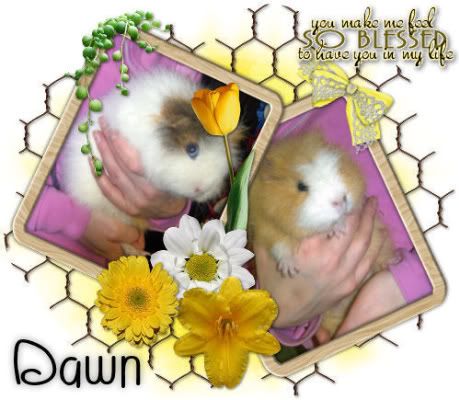Post by Dawn - Admin on Apr 20, 2006 20:17:37 GMT
Syringe feeding info
Guinea pigs metabolize food quickly; according to "Diseases of Domestic Guinea Pigs", the food intake should be 6 gm of food per 100 gm body weight, of which 2 - 4 gm is dry food. What this translates into is that gpigs are eating machines; syringe feeding is best accomplished with many smaller feedings rather than two or three big meals.
I have had some syringe feeding experience; I don't claim to be an expert (your results may vary), but this is what worked for me:
Obtain a 3 cc syringe, and cut off the nozzle end; you now have a tube with a plunger. A 5cc is too large (causes the animal to gag); a 1 cc is too small (there are also some feeding syringes I've seen; they look like they would work, but I haven't used one).
Create a "pig mash" food. There are many "recipes"; I used to use crushed pellets with a small dab of Nutrical as a "binder", then enough water or juice to make a paste the consistency of toothpaste. I would recommend instead baby food (mixed vegetables or whatever veggie your gpig likes that's available), since this may taste better. You may have to experiment to find out what she likes best.
Load up the syringe, and holding the gpig on your lap (we didn't use a towel; just held the gpig facing away, put my hand under his chest and lifted him to a "standing" position) apply 1/3 to 1/2 syringeful just in back of the incisors. You will have to experiment to find a feeding position that both you and your pig are comfortable with. Offer a plastic drop of water or juice between mouthfulls, or every so often.
An "average" feeding is 15 - 21 cc's (five to seven 3 cc syringefulls), and at least 4 feedings a day. If you can feed more often, you can lessen the amount. Remember, these are "guessimate" figures; it worked with my animal, but that doesn't mean it would work with anyone else's.
The critical thing is to keep her eating; this should only be a temporary measure for a day or two until she eats on her own.
Info found at: beanmakers.com/#useful
Guinea pigs metabolize food quickly; according to "Diseases of Domestic Guinea Pigs", the food intake should be 6 gm of food per 100 gm body weight, of which 2 - 4 gm is dry food. What this translates into is that gpigs are eating machines; syringe feeding is best accomplished with many smaller feedings rather than two or three big meals.
I have had some syringe feeding experience; I don't claim to be an expert (your results may vary), but this is what worked for me:
Obtain a 3 cc syringe, and cut off the nozzle end; you now have a tube with a plunger. A 5cc is too large (causes the animal to gag); a 1 cc is too small (there are also some feeding syringes I've seen; they look like they would work, but I haven't used one).
Create a "pig mash" food. There are many "recipes"; I used to use crushed pellets with a small dab of Nutrical as a "binder", then enough water or juice to make a paste the consistency of toothpaste. I would recommend instead baby food (mixed vegetables or whatever veggie your gpig likes that's available), since this may taste better. You may have to experiment to find out what she likes best.
Load up the syringe, and holding the gpig on your lap (we didn't use a towel; just held the gpig facing away, put my hand under his chest and lifted him to a "standing" position) apply 1/3 to 1/2 syringeful just in back of the incisors. You will have to experiment to find a feeding position that both you and your pig are comfortable with. Offer a plastic drop of water or juice between mouthfulls, or every so often.
An "average" feeding is 15 - 21 cc's (five to seven 3 cc syringefulls), and at least 4 feedings a day. If you can feed more often, you can lessen the amount. Remember, these are "guessimate" figures; it worked with my animal, but that doesn't mean it would work with anyone else's.
The critical thing is to keep her eating; this should only be a temporary measure for a day or two until she eats on her own.
Info found at: beanmakers.com/#useful





